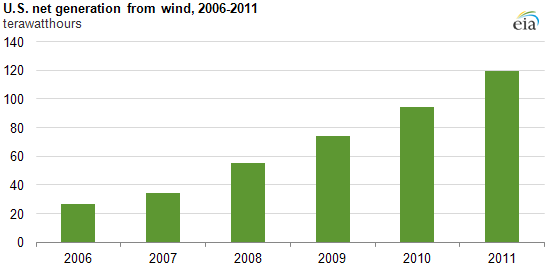Wenyuan Yin
Ek132
Wind energy is a clean energy that can be converted into wind power of which wind turbines is the most useful method to make electrical power. Compared to fossil fuels, wind power has obvious advantages. For example, wind power is renewable, plentiful, widely distributed and does not emit green house gases[1]. The wind power is being widely used and developing throughout the world. The net generation of electricity from wind turbines in the United States keeps increasing since 2006 (Figure 1). Generation from wind turbines increased 27% in 2011 compared to 2010 with a continuing a trend of rapid growth in the United States[2] and wind energy production is growing at a high rate of 25% per annum. Moreover, the monetary cost per unit of energy produced is similar to the cost for new coal and natural gas installations, which means that wind power installation is no less economy than the traditional ones. Despite the significant environmental benefits of wind turbine energy has, there are potentially very dangerous health impacts that may caused by wind turbines, which may be the most controversial aspect of the use of wind power around the world.

Source: U.S. Energy Information Administration, Electric Power Monthly.
Ice throw is one of the health impact of wind turbine. The Wisbech Standard reports that during winter in a small town of England, wind turbine almost turned into weapon. “Lumps of ice three or four feet long flew through the air” and smashed into a carpet showroom and a parking lot. Although no one was hurt in this accident, this small town will forever be terrified during winter with huge wind turbine up in the air[3]. A swiss report researched a turbine near a ski area in Swiss and found out that “The most dangerous place for ice was underneath the turbine, but about 5 percent of fragments landed more than 80 meters — or 260 feet — from the turbine.” Figure 2 shows the Distribution of ice throw relative to the wind turbine. (Source: Wind Turbine Ice Throw Studies in the Swiss Alps).

Distribution of ice throw relative to the wind turbine. (Source: Wind Turbine Ice Throw Studies in the Swiss Alps)
Moreover, industrial wind turbines cause load noises that could cause sleep loss. A study called “Effects of Industrial Wind Turbine Noise on Sleep and Health” claimed that “The levels of sleep disruption and the daytime consequences of increased sleepiness, together with the impairment of mental health … strongly suggest that the noise from IWTs [industrial wind turbines] results in similar health impacts as other causes of excessive environmental noise,” “The degree of effect on sleep and health from IWT noise seems to be greater than that of other sources of environmental noise, such as, road, rail and aircraft noise.” The study also suggested that the wind noise problem of the wind turbine may cause severe health issue for those who live near them. About 25% of those living closer to the turbines are reported having depression or anxiety since the turbines began spinning while outer group samples showed no these problems. [4]
In the research of Dr. Nina Pierpont of New York, a series of syndroms that people living closer to the wind turbine is called “wind turbine syndrome” and it is determined that its primary cause is the effect of low-frequency wind turbine noise on the organs of the inner ear. [5]
References
1. Fthenakis, V.; Kim, H. C. (2009). “Land use and electricity generation: A life-cycle analysis”. Renewable and Sustainable Energy Reviews 13 (6–7): 1465. doi:10.1016/j.rser.2008.09.017
3. Nick Sambides Jr. “Industrial wind turbines could cause sleep loss, study claims” Bangor Daily News. November 27, 2012. http://www.sunjournal.com/news/farm/2012/11/27/industrial-wind-turbines-could-cause-sleep-loss-st/1286367
4. Galbraith, Kate. “Ice-Tossing Turbines: Myth or Hazard?” The New York Times. December 9, 2008. http://green.blogs.nytimes.com/2008/12/09/ice-tossing-turbines-myth-or-hazard/
5. “Noise and Health Effects of Large Wind Turbines.” National Wind Watch, Inc. Oct. 25, 2006. http://www.wind-watch.org/ww-noise-health.php
6. “Wind Power” Wikipedia, http://en.wikipedia.org/wiki/Wind_power
7. Independent Expert Panel of Massachusetts Government. “Wind Turbine Health Impact Study” MassGov. January 2012. http://www.mass.gov/dep/energy/wind/turbine_impact_study.pdf
8. Sangrillo, Mike. “Home-Sized Wind Turbines and Flying Ice.” Windletter. Volume 22, Issue No. 6, June 2003. http://www.renewwisconsin.org/wind/Toolbox-Fact%20Sheets/Ice%20shedding.pdf